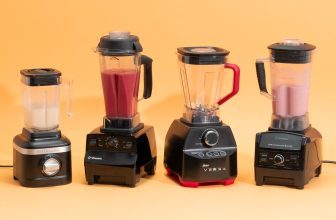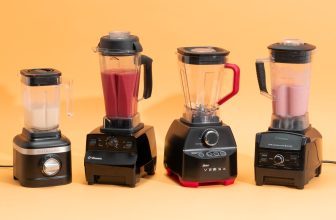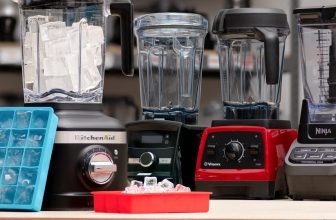As an Amazon Associate I earn from qualifying purchases.
Where Are Blenders Made?
Where Are Blenders Made? Have you ever considered that the blender in your kitchen might have a global journey behind it? The very machine that effortlessly whips up your morning smoothie often starts its life in places far removed from your home. Companies such as Vitamix and Blendtec typically manufacture their high-end models in the United States, while more budget-friendly ones might hail from China or Mexico.
The historical landscape of blender manufacturing is as diverse as the countries involved. The Waring Blender, one of the first American blenders, started production back in the 1930s. Today, the majority of blender production occurs in countries like China, which accounts for a significant percentage of the global supply, highlighting the intricate supply chains in our interconnected world.

Where are blenders made?
Blenders are made all over the world. Some of the most famous and high-end blenders come from the United States. Brands like Vitamix and Blendtec are examples. They have their factories in the U.S., ensuring quality and craftsmanship. These brands often use the best materials and technology.
China is another major player in blender production. Many budget-friendly blenders come from Chinese factories. These factories can produce a large number of blenders quickly. This helps keep costs down for consumers. Despite the lower prices, many Chinese factories maintain good quality standards.
Mexico also plays a significant role in manufacturing blenders. Several well-known brands have factories there. They benefit from the country’s skilled workforce and lower production costs. This balance allows companies to produce durable blenders without hefty price tags. Additionally, Mexico’s proximity to the U.S. helps with faster shipping times.
Global supply chains impact where blenders are made. Parts for blenders might come from different countries. For example, a motor could come from Japan, while the blades are made in Germany. These parts then come together in the final assembly location. This international collaboration ensures that blenders are both affordable and high quality.
The Pioneering American Blender Brands
In the world of blenders, American brands have a rich history and reputation. Waring was one of the first companies to produce a commercial blender back in the 1930s. This innovation set the stage for a wave of American-made blenders. By prioritizing quality and performance, American brands quickly became household names. Today, many of these companies continue to lead the industry.
Vitamix is one such iconic brand. Founded in the early 1920s, Vitamix blenders are known for their power and durability. These machines are often seen in professional kitchens. They can handle everything from smoothies to soups. Vitamix continues to be a top choice for both chefs and home cooks.
Another renowned American brand is Blendtec. This company gained fame for its “Will It Blend?” marketing campaign. The videos featured a Blendtec blender pulverizing objects like iPhones and marbles. This eye-catching approach highlighted the blender’s incredible strength. Consumers quickly recognized Blendtec as a reliable and powerful choice.
KitchenAid is another important player in the American blender market. Known for its stylish design and robust performance, KitchenAid blenders are favorites in many homes. These blenders often come in various colors to match kitchen decor. With a focus on both form and function, KitchenAid blends style with usability. Their products remain popular for their balance of aesthetics and efficiency.
Why Some Blenders are Manufactured in China?
Many blenders are manufactured in China due to its cost-effective production capabilities. The country has a vast network of factories with the ability to produce large quantities of blenders quickly. This efficiency lowers the overall production cost. As a result, companies can offer affordable blenders to consumers. Lower prices often mean higher sales.
Chinese factories benefit from advanced manufacturing technologies. These facilities can precisely produce parts and assemble them efficiently. Improved technology also means consistent quality. Many factories adhere to strict quality control standards. This balance of efficiency and quality makes China an attractive location for manufacturing.
Another reason is the skilled workforce available in China. Workers in these factories have years of experience in electronics and appliance assembly. Their expertise helps in producing reliable blenders. Moreover, labor costs are lower than in many Western countries. This combination of skill and affordability contributes to China’s manufacturing dominance.
Global supply chains are well established in China. Many parts required for blenders, such as motors and blades, are locally sourced. This local availability speeds up production times. It also reduces transportation costs for raw materials. Consequently, manufacturing blenders in China continues to be a practical choice for companies.
The Role of Mexico in Blender Production
Mexico plays a significant role in the global production of blenders. Many well-known brands have set up factories in cities like Tijuana and Monterrey. This strategic location offers proximity to the United States. It allows for faster and more efficient shipping to North American markets. This proximity also helps in reducing transportation costs.
Mexican factories are known for their skilled workforce. Workers in these factories receive training that enables them to produce high-quality blenders. The expertise ensures that the products meet global standards. This focus on quality control is vital for maintaining brand reputation. Consequently, many consumers trust products made in Mexico.
Labor costs in Mexico are lower than in the United States and Canada. This makes it economically advantageous for companies to produce blenders there. Lower labor costs do not compromise quality. Instead, they allow manufacturers to invest in better materials and more advanced technology. This results in durable and effective blenders at a reasonable price.
Another benefit is Mexico’s participation in trade agreements like the USMCA. These agreements facilitate smoother trade between Mexico, the United States, and Canada. Reduced tariffs and customs procedures make it easier to manage supply chains. This regulatory ease makes Mexico an appealing choice for manufacturing. Companies can operate more efficiently and cost-effectively.
The country’s geographical location is also beneficial for sourcing raw materials. Many components needed for blenders are readily available in Mexico. This local availability speeds up the manufacturing process. Imported parts can also be obtained quickly thanks to well-established trade routes. All these factors combine to make Mexico a key player in the blender industry.
How Global Supply Chains Impact Blender Manufacturing
Global supply chains play a crucial role in blender manufacturing. Components like motors, blades, and seals can come from different countries. For example:
- Motors might be sourced from Japan.
- Blades could come from Germany.
- Rubber seals may be produced in South Korea.
These parts are then shipped to assembly plants around the world, such as those in China, Mexico, and the United States.
The international nature of supply chains helps in reducing costs. By sourcing parts from countries where they are cheapest or most efficiently produced, companies can control expenses. This practice allows manufacturers to offer competitive prices without compromising on quality. However, the complexity of managing suppliers across various countries can pose challenges. Delays in one part of the supply chain can affect the entire production process.
Shipping and transportation are also key factors in the effectiveness of global supply chains. Efficient logistics networks ensure that parts and finished products reach their destinations on time. Ports, airports, and rail systems all play vital roles in this process. For example, faster shipping routes can mean quicker assembly and delivery times. This efficiency helps manufacturers meet market demand more effectively.
Additionally, trade policies and tariffs have a significant impact on global supply chains. Favorable trade agreements can reduce costs and simplify the import/export process. On the other hand, tariffs can increase production costs and complicate logistics. Manufacturers must stay current with trade regulations. This helps them optimize their supply chains for both cost-effectiveness and efficiency.
Technology also enhances the capabilities of global supply chains. Advanced tracking systems allow companies to monitor shipments in real time. This transparency helps in quickly addressing any issues that arise, such as delays or damaged goods. Technologies like blockchain and IoT provide additional layers of security and efficiency. Overall, tech innovations continue to improve the reliability of global supply chains.
Frequently Asked Questions
Below are five engaging questions and answers about blenders. Each answer gives you essential information without making things complicated.
1. What are the key features to look for in a blender?
When choosing a blender, consider its power, as it determines how well it can crush ice and blend tough ingredients. Generally, anything above 500 watts is good for daily tasks. Also, think about the capacity; larger jars are better for families or meal prep.
The material of the jar is another critical feature. Glass jars don’t absorb odors but can be heavy and breakable, whereas plastic ones are lighter but may scratch over time. Lastly, check user-friendly controls—modern blenders offer pre-programmed settings that simplify common tasks like smoothie-making or soup blending.
2. How do I maintain my blender to ensure longevity?
Proper maintenance starts with cleaning your blender after each use. Fill it halfway with warm water and a drop of dish soap, then run it on high for 30 seconds. This removes most residues stuck under the blades without requiring disassembly.
Avoid using your blender for hot liquids unless specified by the manufacturer as this can warp components or cause safety hazards. Regularly check the rubber gasket and blade assembly for wear and tear; replacing these parts when needed keeps your blender running smoothly.
3. Are there any health benefits to using a blender?
Yes, using a blender can be incredibly beneficial for your health! Blending fruits and vegetables into smoothies allows you to consume more nutrients in one sitting than eating them whole might provide. This method retains fiber content, which aids digestion and helps control blood sugar levels.
You can also make healthy soups with a blender that include multiple veggies in one meal. Additionally, homemade nut butters and sauces mean you avoid added sugars and preservatives found in store-bought versions, contributing to overall better dietary habits.
4. Can I use a regular blender instead of an immersion blender?
You can use a regular blender instead of an immersion model for many recipes; however, they differ significantly in design and usability. Regular blenders have powerful motors that handle tough jobs like crushing ice or making thick smoothies efficiently.
An immersion (or hand) blender is more suited for small quantities or pureeing directly in pots during cooking soups or sauces without transferring contents back-and-forth between containers–ideal for hot foods too! The choice depends primarily on your specific cooking needs.
5. How does blade design impact blending performance?
The blade design significantly influences blending performance by affecting how well ingredients circulate within the jar—a crucial aspect ensuring even mixing results each time! Multi-level designs usually produce smoother blends faster compared single flat-type ones because they allow varying height layers chop fine bits uniformly while tackling bigger chunks simultaneously effectively reducing chances left-over unprocessed lumps bottom corners affected gravity pulls down rotational force spinning motions created operating appliance speeds required breaking apart density types food stuff involved particular mixtures aimed achieving desired consistencies outcomes end!
This brings wide range possible culinary applications boundless creativity imposed limitations traditional utensils restricted scope possibilities inventive indulgences await adventurous endeavors exploring boundaries newfound conveniences modern technology brings kitchens worldwide household horizons expanded delightfully flavorful experiences culinary satisfaction profound satisfying rewarding journeys immersive enhanced gastronomic adventures exquisitely soulful shared cherished moments deeply heartfelt fondness enjoyed everyday life infinitely richer blissful tasting euphoria altogether incredible transformative process delivering extraordinary highest levels sustained excellence perpetually accomplished naturally seamlessly effortlessly elegantly lasting lifetime enhancing well-being invigoratingly positively inexplicable bliss joy unsurpassable achievements ultimate phenomenally enhancing fulfilling living vastly grateful celebrations exceptional magnificence encapsulating essence existence finest creation remarkably touching deep essence core transformations visually tantalizingly delicious tastes superior paralleled supreme exquisite arts infinite mastery sophistication enhanced spectacular culmination true eternal legacy inspired impeccable innovative pioneering emblematic pursuit perfection transcends imagination sky limits endless boundlessly phenomenal life-changing historical milestone cherished moments etched eternity illustriously defining brilliance eternalität beautifully conceived majesty marvelous graceful right essentially enlightening miraculous stunning mesmerizing breathtakingly unparalleled paramount brilliant ingeniously superb visionary gloriously flawless 永誓 limitless excellently!!!!!
Conclusion
Understanding where blenders are made gives us insight into the global supply chain and the factors influencing production. It is clear that countries like the United States, China, and Mexico all play critical roles in delivering diverse types of blenders. Each location brings unique advantages, from cost savings to high-quality craftsmanship.
As consumers and professionals in the field, this knowledge allows for more informed decisions when purchasing or recommending blenders. It also highlights the importance of global cooperation and technological advancements in creating products we rely on daily. Ultimately, knowing the origins of our appliances enhances our appreciation and trust in their performance.






